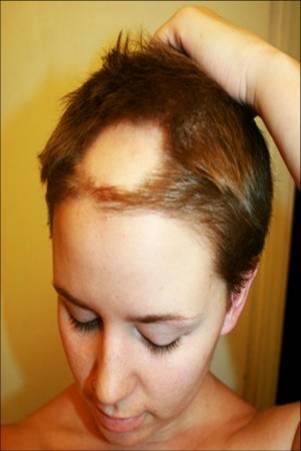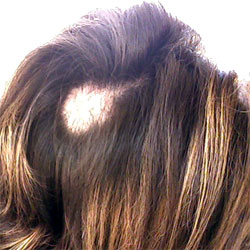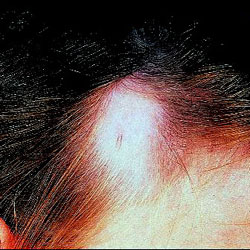Baldness in women is not a frequently discussed topic as men are more supposed to exhibit patterns and symptoms of baldness.
Women are supposed to have a scalp full of hair and hair loss is supposed to occur in old women only. Hair loss has nothing to do with age and may occur at young age or middle age too. However, it is important to note that many women may experience hair loss in their early 20’s, especially in women who have experienced early puberty.
If this left untreated, hair loss may reach an advanced stage.
 Female hair loss
Female hair loss
Hair loss, thinning as well as loss of hair scalp in women has been fully recognized as a medical problem that needs an immediate treatment by a hair restoration specialist.
In order to understand the female hair loss pattern, let us first find out about hair growth pattern:
- Normally, hair grows at an average of an inch in two months. This may differ from person to person
- Normal hair shedding is around 100-150 hair per day. Number of hair shedding per day more than this count calls for attention.
- An increased rate of hair loss causes thinning of hair resulting in female pattern baldness.
Initially, it can be self diagnosed. One may find more hair on the pillow, hair brush, and towel or even on the floor. Increase in the number calls for an alarm and an early physicians prescription.
Female Androgenetic Alopecia:
Pattern of hair loss in women are many. Female Androgenetic Alopecia is the most common occurring female hair loss pattern that also remains the same for men.
What is female pattern androgenetic alopecia?
Gradual hair thinning occurs over the front of the head. The thinning of hair occurs in diffuse patterns, unlike men where baldness is prominent and frank.
Androgenic Alopecia causes heavy reduction in hair on the scalp.
what causes female androgenetic alopecia:
The production of androgenetic hormones,male hormones, in the body and their effect on the hair follicle leads to the disorder.
Hormonal imbalances and changes are also responsible, especially for hair loss during puberty and early 20’s.
Women hair thinning:
The androgenetic hormones as a factor remain pretty much the same for baldness in both the genders. The pattern of hair loss however remains different. There are three patterns of hair loss in female androgenetic alopecia:

Pattern I: Thinning of the hair on the central scalp.
Pattern II: Thinning of the hair along with visible patches of hair loss.
Pattern III: Male-pattern hair loss at the front of the scalp to mid-scalp. But, “cue ball” baldness pattern remains rare.
Other patterns may include:
- Greater hair loss towards the back of the scalp.
- Prominent thinning towards the front scalp, excluding the frontal hairline.
- Thinning of the hair at the front scalp along with the frontal hairline.
Difference between male and female androgenetic hair loss pattern:
Unlike men, women exhibit miniaturizing hair of variable diameter that does not uniformly grow smaller in diameter.
Remember:
Miniaturizing hair is not essentially a diagnostic feature of androgenetic alopecia. The pattern may be a cause of other reasons as well. Women with menapause may also exhibit such patterns.
The precise diagnosis should always be made by a physician hair restoration specialist. Correct diagnosis of hair loss can be treated medically or surgically.
There are many patterns in hair loss that keep varying in women and therefore individual diagnosis is recommended.
Hair loss in Women: Non-pattern causes
When baldness comes to women, the factors other than androgenetic alopecia are quite common.
Some of the most common of these causes are:
Alopecia Areata:
 Alopecia Areata is necessarily an autoimmune disorder with visible patches of hair loss. Sometimes eyebrows and other hair bearing parts also begin to show hair loss. The thinning may occur in both diffuse as well as extensive patterns. Proper diagnosis is needed for the treatment.
Alopecia Areata is necessarily an autoimmune disorder with visible patches of hair loss. Sometimes eyebrows and other hair bearing parts also begin to show hair loss. The thinning may occur in both diffuse as well as extensive patterns. Proper diagnosis is needed for the treatment.
Loose-anagen syndrome
 Loose-Anagen syndrome is a condition that occurs primarily in people with light pigment hair. Hair roots in such people is not deep set and rests loosely in the follicles. Combing, shampooing as well as pulling of hair may also cause hair loss. The condition mostly appears in childhood but relaxes as age proceeds.
Loose-Anagen syndrome is a condition that occurs primarily in people with light pigment hair. Hair roots in such people is not deep set and rests loosely in the follicles. Combing, shampooing as well as pulling of hair may also cause hair loss. The condition mostly appears in childhood but relaxes as age proceeds.
Scarring/traction Alopecia:
 Scarring/traction Alopecia hair loss occurs mainly when the scalp gets scarred which occurs due to continuous traction or pressure on the follicles. The pattern is most visible in African as well as American women.
Scarring/traction Alopecia hair loss occurs mainly when the scalp gets scarred which occurs due to continuous traction or pressure on the follicles. The pattern is most visible in African as well as American women.
Factors leading to the disorder are many. Persistent braiding as well as crown rowing is one of the causes. Even post menopausal women may suffer the problem followed by inflammantion and scarring of the hair follicles.
Trichotillomania:
 Trichotillomania is a typical patchy hair thinning process that occurs in selected areas. Psychological and emotional reasons are also quite responsible for trichotillamania. These two aspects need to be treated for the treatment of hair loss due to trichotillamania.
Trichotillomania is a typical patchy hair thinning process that occurs in selected areas. Psychological and emotional reasons are also quite responsible for trichotillamania. These two aspects need to be treated for the treatment of hair loss due to trichotillamania.
Triangular Alopecia:
 Triangular Alopecia Hair loss occurs around the temples in the temporal areas and may begin as early as in childhood. Hair loss is complete and only a few strands, a few lines as well as thin diameters or hair may remain. The problem can be treated by medicines as well as surgery.
Triangular Alopecia Hair loss occurs around the temples in the temporal areas and may begin as early as in childhood. Hair loss is complete and only a few strands, a few lines as well as thin diameters or hair may remain. The problem can be treated by medicines as well as surgery.
Telogen Effluvium:
 Telogen Effluvium occurs with a greater area of scalp hair shifting into the shedding phase.
Telogen Effluvium occurs with a greater area of scalp hair shifting into the shedding phase.
Hormonal, nutritional, psychological as well as drug and stress related causes may lead to the kind of hair loss.
Other factors:
- Hair loss can occur after pregnancy.
- Discontinuation of birth control pills.
- Sudden physical or psychological stress.
These types of hair loss are usually temporary. Once treated well hair may be recovered within eight months.
Temporary hairfall solutions:
Perming, dyeing, curling etc may add volume to the hair.Hair additions like hair extensions may also help exhibit voluminous hir.
Permanent hairfall solutions:
Consult a specialist who can suggest you proper medication, treatment or other options such as hair weaving, hair transplantation etc.
